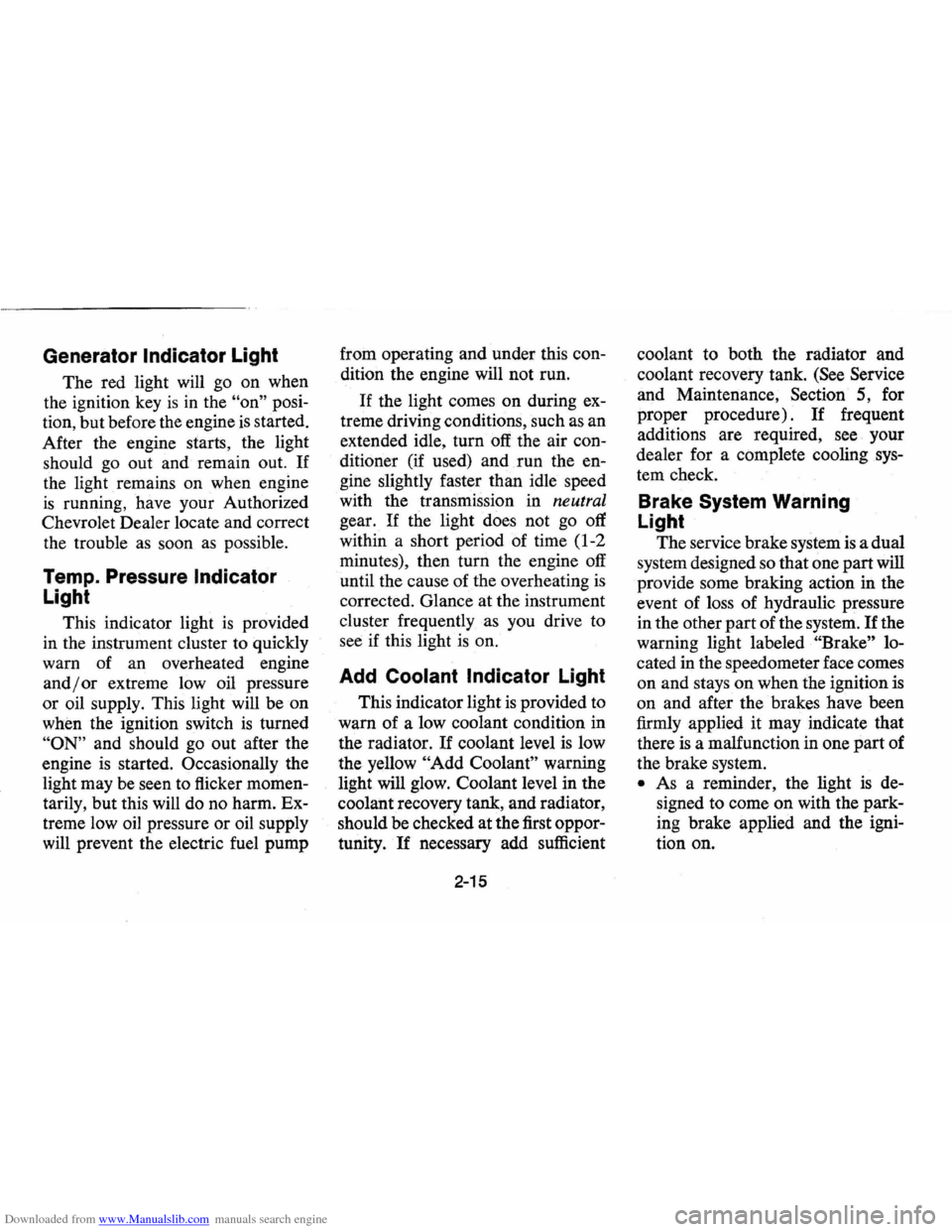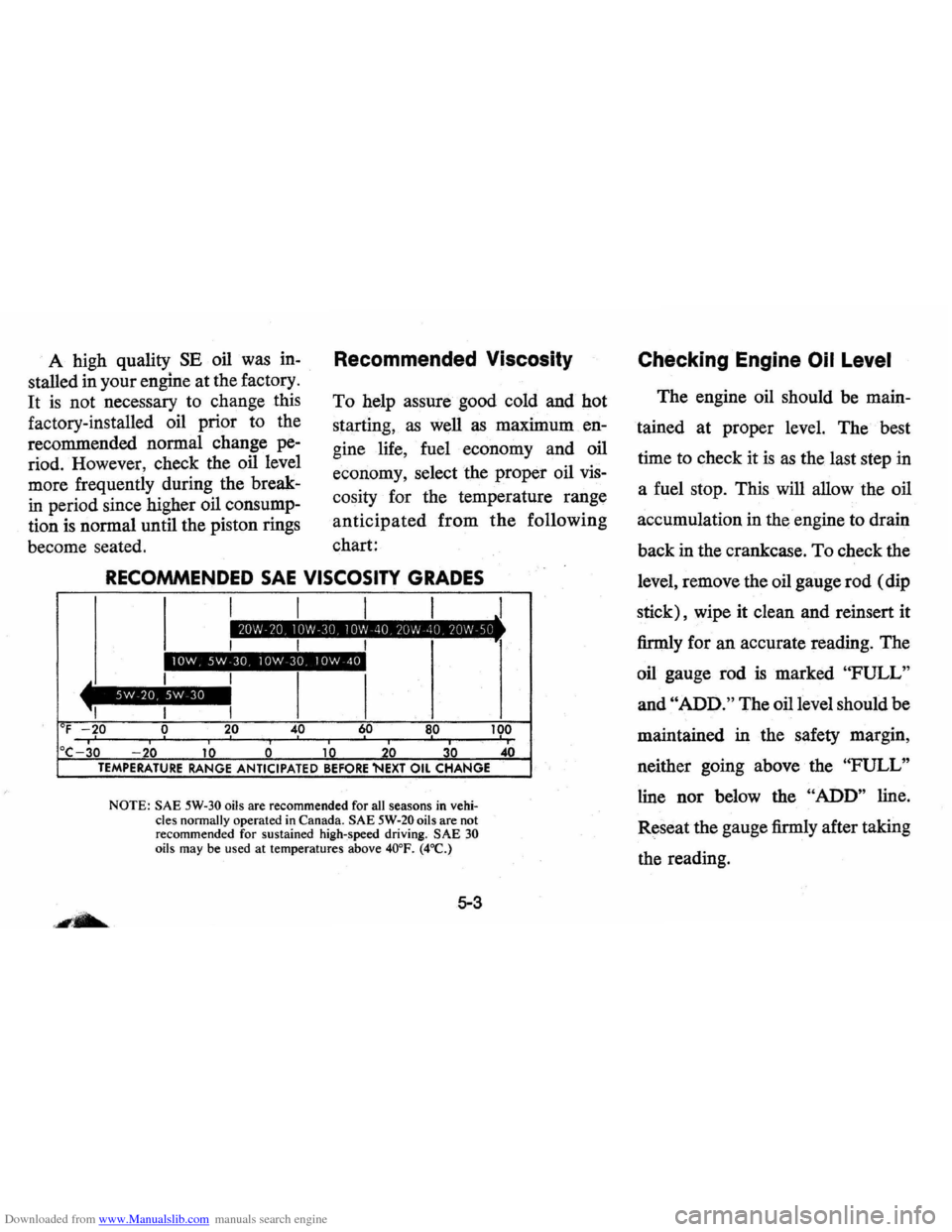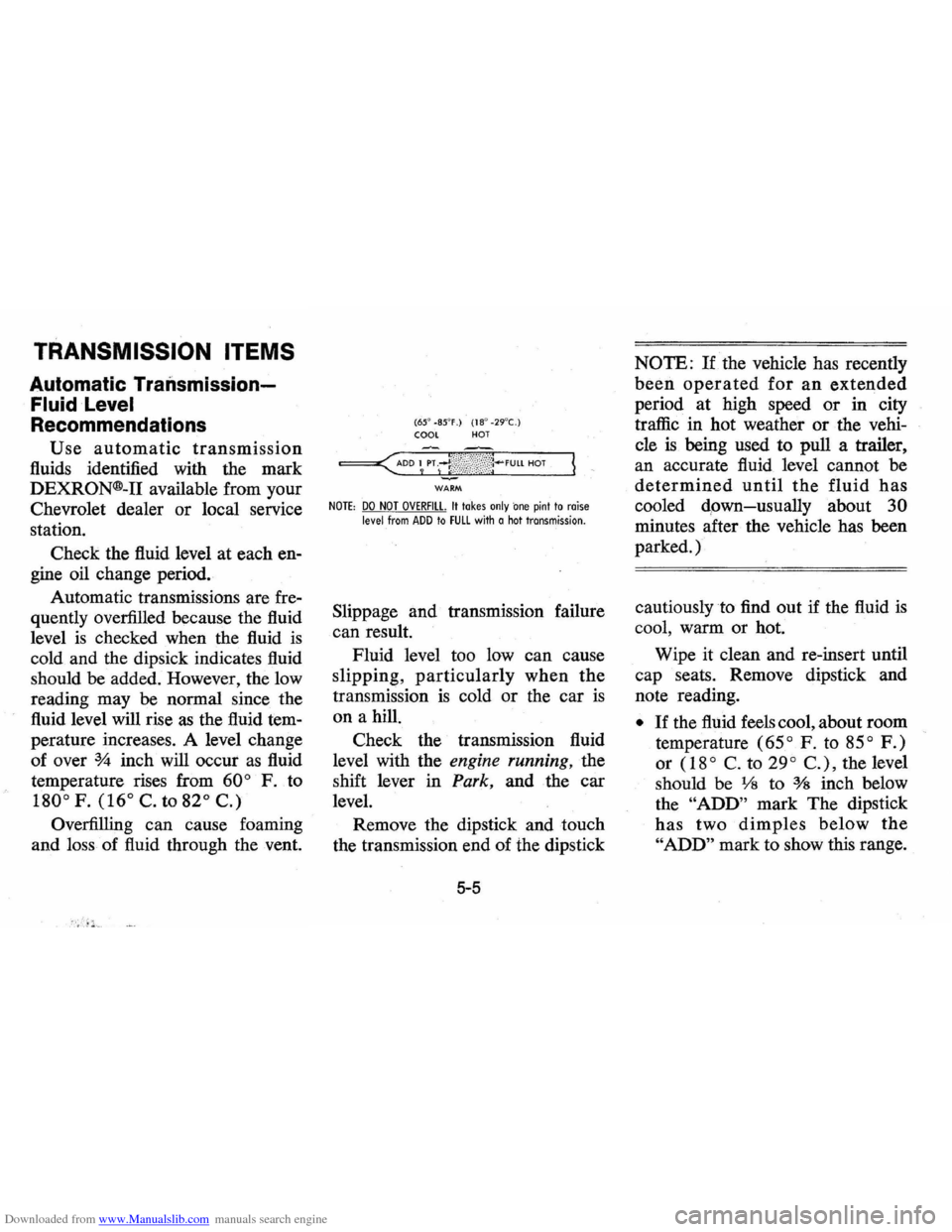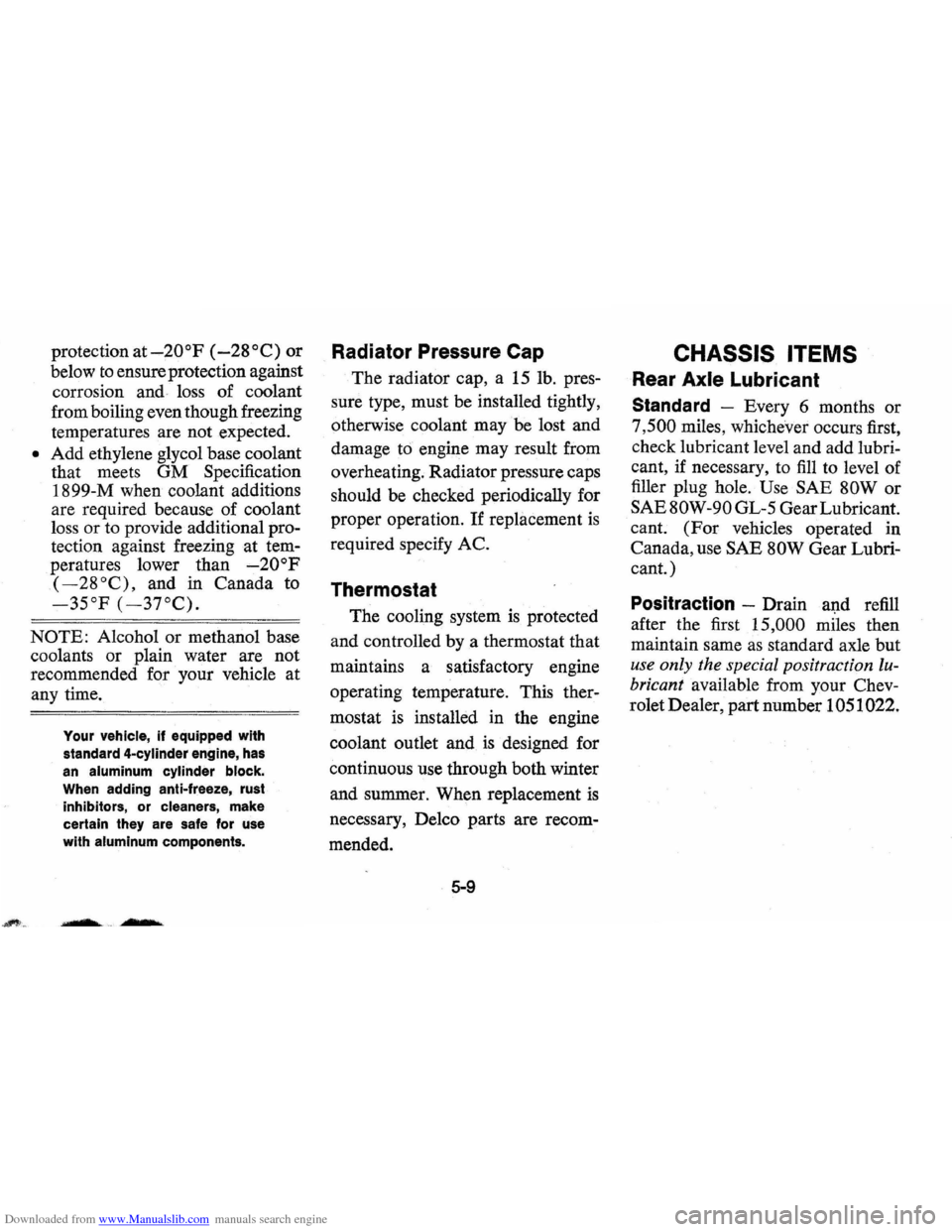1976 CHEVROLET VEGA oil level
[x] Cancel search: oil levelPage 31 of 87

Downloaded from www.Manualslib.com manuals search engine Generator Indicator Light
The red light will go on when
the ignition key
is in the "on" posi
tion, but before the engine
is started.
After the engine starts, the light
should go out and remain out.
If
the light remains on when engine
is running, have your Authorized
Chevrolet Dealer locate and correct
the trouble
as soon as possible.
Temp. Pressure Indicator
Light
This indicator light is provided
in the instrument cluster to quickly
warn of an overheated engine
and/or extreme low oil pressure
or oil supply. This light will be on
when the ignition switch is turned
"ON" and should go out after the
engine
is started. Occasionally the
light may be seen to flicker momen
tarily, but this will do no harm. Ex
treme low oil pressure or oil supply
will prevent the electric fuel pump from
operating and under this con
dition the engine will not run.
If the light comes on during ex
treme driving conditions, such
as an
extended idle, turn off the air con
ditioner (if used) and run the en
gine slightly faster than idle speed
with the transmission in
neutral
gear. If the light does not go off
within a short period of time (1-2
minutes), then turn the engine off
until the cause of
the overheating is
corrected. Glance at the instrument
cluster frequently
as you drive to
see if this light is on.
Add Coolant Indicator Light
This indicator light is provided to
warn of a low coolant condition in
the radiator.
If coolant level is low
the yellow
"Add Coolant" warning
light will glow. Coolant level in the
coolant recovery tank, and radiator,
should be checked at the first oppor
tunity.
If necessary add sufficient
2-15
coolant to both the radiator and
coolant recovery tank.
(See Service
and Maintenance, Section 5, for
proper procedure) .
If frequent
additions are required, see your
dealer for a complete cooling sys
tem check.
Brake System Warning
Light
The service brake system is a dual
system designed so that one part will
provide some braking action in the
event of loss of hydraulic pressure
in the other part of the system.
If the
warning light labeled
"Brake" lo
cated in the speedometer face comes
on and stays
on when the ignition is
on and after the brakes have been
firmly applied
it may indicate that
there
is a malfunction in one part of
the brake system.
• As a reminder, the light is de
signed to come
on with the park
ing brake applied and the igni
tion on.
Page 61 of 87

Downloaded from www.Manualslib.com manuals search engine A high quality SE oil was in
stalled in your engine at the factory.
It is not necessary to change this
factory-installed oil prior to the
recommended normal change pe
riod. However, check the oil level
more frequently during the break
in period since higher oil consump
tion
is normal until the piston rings
become seated.
Recommended Viscosity
To help assure good cold and hot
starting, .
as well as maximum en
ginelife, fuel economy and oil
economy, select the proper oil
vis
cosity for the temperature rang¥
anticipated from the following
chart:
RECOMMENDED SAE VISCOSITY GRADES
I I I I 20N 20 lOW-3~ 10N')0 2UN ·;0 20,V sc
lOW 5w 30 lOW 30 lOW 40
TEMPERATURE RANGE ANTICIPATED BEFORE 'NEXT OIL CHANGE
NOTE : SAE 5W-30 oils are recommended for all Seasons in vehicles normally operated in Canada. SAE 5W-20 oils are not
recommended for sustained high-speed driving. SAE 30 oils may be used at temperatures above 40°F. (4°C.)
5-3
100 , i 40
Checking Engine Oil Level
The engine oil should be main
tained at proper level. The best
time to check it
is as the last step in
a fuel stop. This will allow the oil
accumulation in the engine to drain
back in the crankcase. To check the
level, remove the oil gauge rod (dip
stick), wipe it clean and reinsert it
firmly for an accurate reading. The
oil gauge rod is marked "FULL"
and "ADD." The oil level should be
maintained in the safety margin,
neither going above the
"FULL"
line nor below the "ADD" line.
Reseat the gauge firmly after taking
the reading.
Page 63 of 87

Downloaded from www.Manualslib.com manuals search engine TRANSMISSION ITEMS
Automatic Traiismission
Fluid Level
Recommendations
Use automatic transmission
fluids identified with the mark
DEXRON®-II available from your
Chevrolet dealer or local service
station.
Check the fluid level at each en
gine oil change period.
Automatic transmissions are fre
quently overfilled because the fluid
level
is checked when the fluid is
cold and the dipsick indicates fluid
should
be added. However, the low
reading may be normal since the
fluid level will rise
as the fluid tem
perature increases. A level change
of over
% inch will occur as fluid
temperature rises from
60° F. to
180° F. (16° C. to 82° C.)
Overfilling can cause foaming
and loss of fluid through the vent.
(65' -85'F .) (18 ' -29'C.) COOl HOT
WARM
NOTE: DO NOT OVERFill. It takes only 'one pint to raise level from ADD to FUll with a hot transmission.
Slippage and transmission failure
can result.
Fluid level too low can cause
slipping,
particularly when the
transmission is cold or the car is
on a hill.
Check the transmission fluid
level with the
engine running, the
shift lever in
Park, and the car
level.
Remove the dipstick and touch
the transmission end of the dipstick
NOTE: If the vehicle has recently
been operated for an extended
period at high speed or in city
traffic in hot weather
or the vehi
cle
is being used to pull a trailer,
an accurate fluid level cannot be
determined until the fluid has
cooled dpwn-usually about 30
minutes after the vehicle has been
parked.)
cautiously to find out if the fluid
is
cool, warm or hot.
Wipe it clean and re-insert until
cap seats. Remove dipstick and
note reading.
• If the fluid feels cool, about room
temperature
(65° F. to 85° F.)
or (18° C. to 29° C.), the level
should be
Vs to % inch below
the
"ADD" mark The dipstick
has two dimples below the
"ADD" mark to show this range.
Page 67 of 87

Downloaded from www.Manualslib.com manuals search engine protection at -20o
P (-28°C) or
below to ensure protection against
corrosion
and · loss of coolant
from boiling even though freezing
temperatures are not expected.
• Add ethylene glycol base coolant
that meets
GM Specification
1899-M when coolant additions
are required because of coolant
loss
or to provide additional pro
tection against freezing at tem
peratures lower than -20oP
(-28°C), and in Canada to
-35°P (-37°C).
NOTE: Alcohol or methanol base
coolants or plain water are not
recommended for your vehicle at
any time.
Your vehicle, if equipped with
standard 4-cylinder engine, has
an aluminum cylinder block.
When adding anti-freeze, rust
inhibitors, or cleaners, make
certain they are safe for
use
with aluminum components.
Radiator Pressure Cap
The radiator cap, a 15 lb. pres
sure type, must be installed tightly,
otherwise coolant may be lost and
damage
t6 engine may result from
overheating. Radiator pressure caps
should be checked periodically for
proper operation.
If replacement is
required specify AC.
Thermostat
The cooling system is protected
and controlled by a thermostat that
maintains a satisfactory engine
operating temperature. This
ther
mostat is installed in the engine
coolant outlet and
is designed for
continuous use through both winter
and summer. When replacement
is
necessary, Delco parts are recom
mended.
5-9
CHASSIS ITEMS
Rear Axle Lubricant
Standard -Every 6 months or
7,500 miles, whichever occurs first,
check lubricant level and add
lubri
cant, if necessary, to fill to level of
filler plug hole.
Use SAE 80W or
SAE80W-90GL-5 Gear Lubricant.
cant.
(Por vehicles operated in
Canada, use
SAE 80W Gear Lubri
cant.)
Positraction -Drain aJ,ld refill
after the first 15,000 miles then
maintain same
as standard axle but
use only the special positraction lu
bricant available from your Chev
rolet Dealer, part number 1051022.
Page 68 of 87

Downloaded from www.Manualslib.com manuals search engine Front Suspension
Every 6 months or 7,500 miles
Lubricate fittings with water
re
sistant EP Chassis Lubricant which
meets GM Specification
6031M.
NOTE:
Ball joints should not be
lubricated unless their temperature
is +10°F (-12°C), or higher.
During cold weather, they should
be allowed to warm up as necessary
before being lubricated.
Steering Linkage
Every 6 months or 7,500 miles,
lubricate fittings with water resist
ant
EP Chassis Lubricant which
meets GM Specification
6031M.
Power Steering System
Check the fluid level in the pump
reservoir at each oil change period.
Add GM Power Steering Fluid
(or Automatic Transmission Fluid
DEXRON®-II) as necessary to bring
level into proper range
on
filler cap indicator depending upon
fluid temperature.
If at operating temperature (ap
proximately 150°F, 66°C-hot to
the touch), fluid should be between
"HOT" and "COLD" marks. If at
room temperature (approximately
70°F, 22°C), fluid should be bet
ween "ADD" and "COLD" marks.
Fluid does not require periodic
changing.
Standard Steering Gear
The steering gear is factory-
l-t.. __ "AOO"
5-10
filled with steering gear lubricant.
Seasonal change of this lubricant
should not be performed and the
housing should not be
drained-no
lubrication is required for the life
of the steering gear.
Every 30,000 miles, the gear
should be inspected for seal leak
age (actual solid grease-not just
oily film).
If a seal is replaced or
the gear
is overhauled, the gear
housing sould be refilled only with
the proper Steering Gear Lubricant
as noted below.
NOTE: Use only #1051052 (13
oz. container) Steering Gear
Lubri
cant which meets GM Specification
GM 4673M, or its equivalent.
Do not use
EP Chassis Lube,
meeting GM Specification GM
6031M, to lubricate the gear. DO
NOT
OVER-FILL the gear hous
ing.